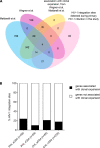HIV-1 integration sites in CD4+ T cells during primary, chronic, and late presentation of HIV-1 infection
- PMID: 33784259
- PMCID: PMC8262285
- DOI: 10.1172/jci.insight.143940
HIV-1 integration sites in CD4+ T cells during primary, chronic, and late presentation of HIV-1 infection
Abstract
HIV-1 is capable of integrating its genome into that of its host cell. We examined the influence of the activation state of CD4+ T cells, the effect of antiretroviral therapy (ART), and the clinical stage of HIV-1 infection on HIV-1 integration site features and selection. HIV-1 integration sites were sequenced from longitudinally sampled resting and activated CD4+ T cells from 12 HIV-1-infected individuals. In total, 589 unique HIV-1 integration sites were analyzed: 147, 391, and 51 during primary, chronic, and late presentation of HIV-1 infection, respectively. As early as during primary HIV-1 infection and independent of the activation state of CD4+ T cells collected on and off ART, HIV-1 integration sites were preferentially detected in recurrent integration genes, genes associated with clonal expansion of latently HIV-1-infected CD4+ T cells, cancer-related genes, and highly expressed genes. The preference for cancer-related genes was more pronounced at late stages of HIV-1 infection. Host genomic features of HIV-1 integration site selection remained stable during HIV-1 infection in both resting and activated CD4+ T cells. In summary, characteristic HIV-1 integration site features are preestablished as early as during primary HIV-1 infection and are found in both resting and activated CD4+ T cells.
Keywords: AIDS/HIV; Molecular biology; T cells; Virology.
Conflict of interest statement
Figures




Similar articles
-
The role of integration and clonal expansion in HIV infection: live long and prosper.Retrovirology. 2018 Oct 23;15(1):71. doi: 10.1186/s12977-018-0448-8. Retrovirology. 2018. PMID: 30352600 Free PMC article. Review.
-
Recurrent HIV-1 integration at the BACH2 locus in resting CD4+ T cell populations during effective highly active antiretroviral therapy.J Infect Dis. 2007 Mar 1;195(5):716-25. doi: 10.1086/510915. Epub 2007 Jan 18. J Infect Dis. 2007. PMID: 17262715
-
Resting CD4+ T cells from human immunodeficiency virus type 1 (HIV-1)-infected individuals carry integrated HIV-1 genomes within actively transcribed host genes.J Virol. 2004 Jun;78(12):6122-33. doi: 10.1128/JVI.78.12.6122-6133.2004. J Virol. 2004. PMID: 15163705 Free PMC article.
-
Assessment of HIV-1 integration in tissues and subsets across infection stages.JCI Insight. 2020 Oct 15;5(20):e139783. doi: 10.1172/jci.insight.139783. JCI Insight. 2020. PMID: 32970634 Free PMC article.
-
The multifactorial nature of HIV-1 latency.Trends Mol Med. 2004 Nov;10(11):525-31. doi: 10.1016/j.molmed.2004.09.006. Trends Mol Med. 2004. PMID: 15519278 Review.
Cited by
-
The Complex Interactions Between HIV-1 and Human Host Cell Genome: From Molecular Mechanisms to Clinical Practice.Int J Mol Sci. 2025 Mar 29;26(7):3184. doi: 10.3390/ijms26073184. Int J Mol Sci. 2025. PMID: 40244051 Free PMC article. Review.
-
New Therapies and Strategies to Curb HIV Infections with a Focus on Macrophages and Reservoirs.Viruses. 2024 Sep 18;16(9):1484. doi: 10.3390/v16091484. Viruses. 2024. PMID: 39339960 Free PMC article. Review.
-
HIV-1 diversity in viral reservoirs obtained from circulating T-cell subsets during early ART and beyond.PLoS Pathog. 2024 Sep 18;20(9):e1012526. doi: 10.1371/journal.ppat.1012526. eCollection 2024 Sep. PLoS Pathog. 2024. PMID: 39292732 Free PMC article.
-
Intact provirus and integration sites analysis in acute HIV-1 infection and changes after one year of early antiviral therapy.J Virus Erad. 2022 Dec 10;8(4):100306. doi: 10.1016/j.jve.2022.100306. eCollection 2022 Dec. J Virus Erad. 2022. PMID: 36582472 Free PMC article.
-
Molecular Biology and Diversification of Human Retroviruses.Front Virol. 2022;2:872599. doi: 10.3389/fviro.2022.872599. Epub 2022 Jun 2. Front Virol. 2022. PMID: 35783361 Free PMC article.
References
Publication types
MeSH terms
LinkOut - more resources
Full Text Sources
Other Literature Sources
Medical
Research Materials

